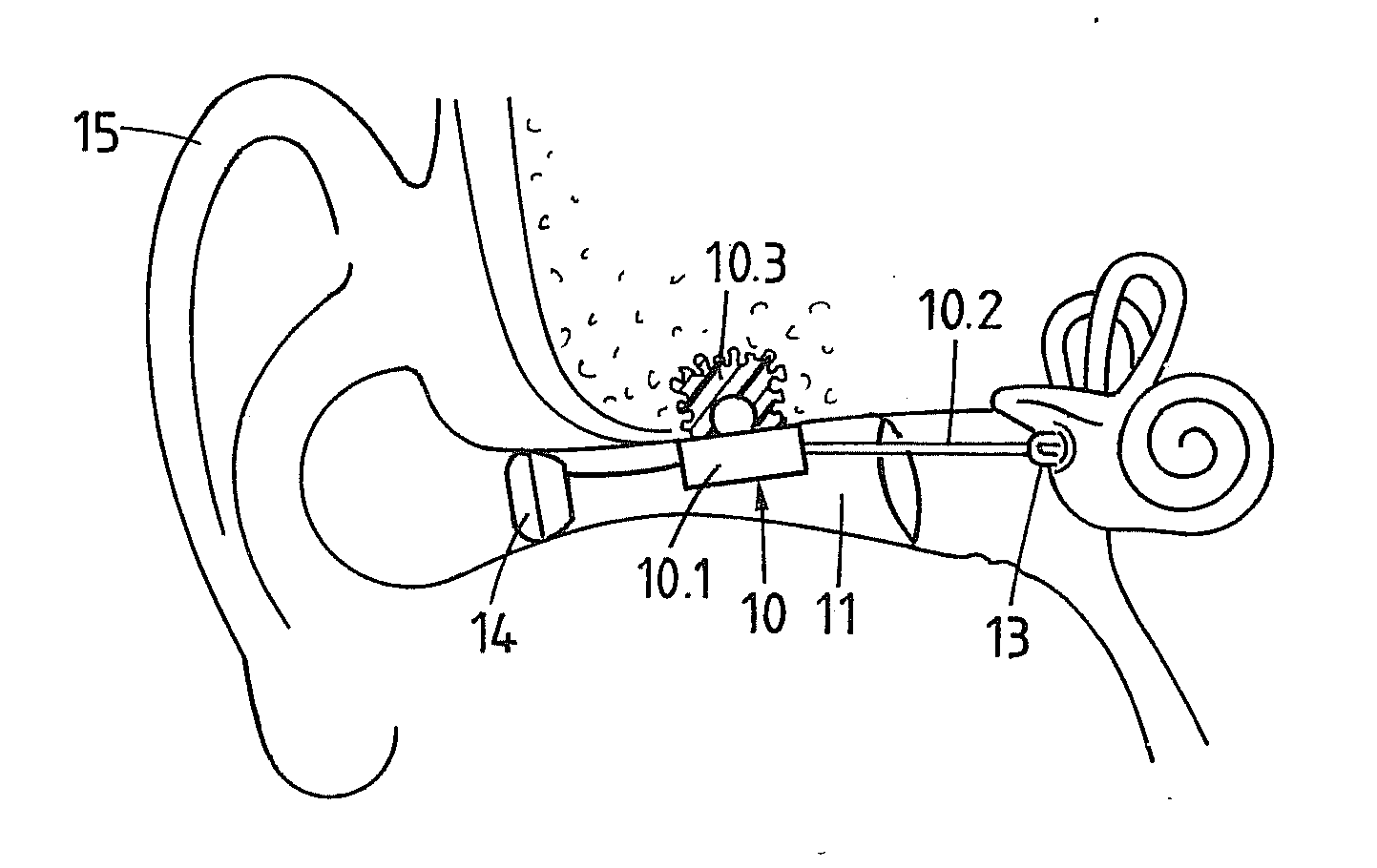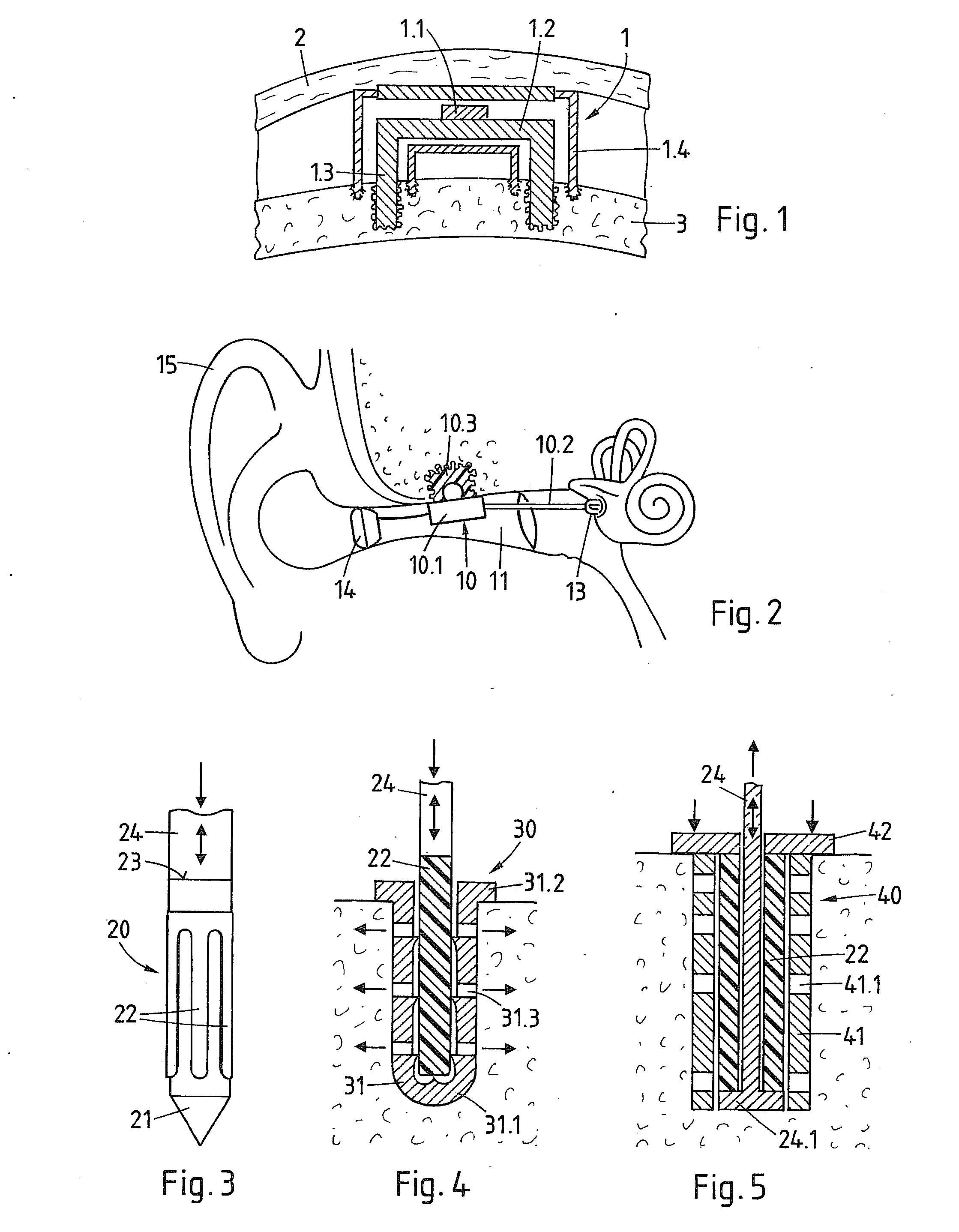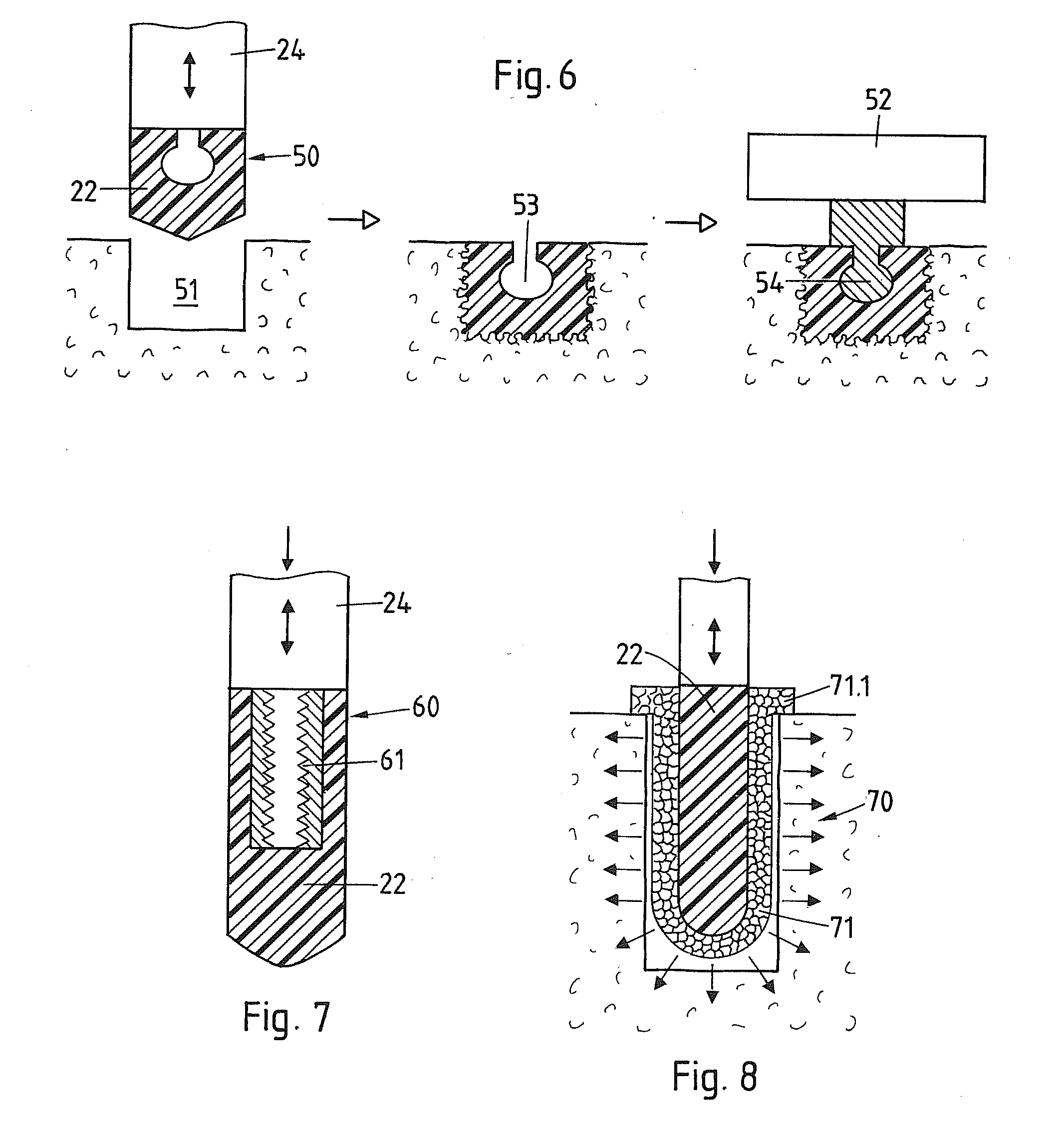[0013]It is the object of the invention to provide a method for anchoring an acoustic element (element having an acoustic function) in a bone of the craniomaxillofacial region, wherein the acoustic properties of this anchorage are to satisfy largely different requirements of differing acoustic elements and are to be easily adaptable to such differing requirements. This means in particular that the anchorage achieved by the method according to the invention either transmits sound from the acoustic element to the bone (or in the opposite direction) with minimal loss and consistently as from the moment of implantation or does not do so (i.e. with maximal loss) without the need of separate damping means. It is a further object of the invention to create an acoustic element which is suitable for being anchored in a bone of the craniomaxillofacial region using the method according to the invention.
[0017]If the method / element is in accordance with the first object of the invention (i.e. optimal
coupling of sound, for example over its full audible spectrum into the bone or vice versa, for example by an osseo-integrative, bony connection of the
actuator in the
skull bone)—i.e. if the anchor element is to transmit sound between the acoustic element and the bone—then the anchor element comprises a
transmitter core made of a material which is able to transmit sound with minimal damping (e.g.
metal such as e.g.
titanium or a
titanium alloy or a
ceramic material such as e.g.
zirconium oxide). For being capable of functioning as sound transmitting means, the
transmitter core firstly needs to be rigidly and directly (no damping means therebetween) attached or attachable to other parts of the acoustic element, and secondly in the implanted state of the anchor elements it needs to be in intimate contact with the bone tissue or the opening provided for the anchor element in some core surface regions (no interface of liquefiable material between such core surface regions and the bone tissue), wherein at least these core surfaces need to be equipped for furthering osseointegration in a per se known manner. The positive fit connection to be established with the aid of the material having
thermoplastic properties is to occupy other core surface regions. Immediately after implantation, the positive fit connection between the anchor element and the bone tissue keeps the
transmitter core in intimate contact with the bone tissue and ensures good sound transmission. As this positive fit connection is not impaired by bone relaxation and not prone to be loosened by loads put on the anchor element or by transmitted sound, sound transmission is not deteriorating after implantation. Preferably the material having thermoplastic properties is bioresorbable and the whole surface of the transmitter core is equipped for enhancing osseointegration such that the named positive fit connection is gradually replaced by osseointegration. If the bone in which the anchor element is to be anchored does not have the mechanical properties which are necessary for a secure anchorage, the material having thermoplastic properties is chosen to be non-bioresorbable, wherein the liquefied material penetrated into the bone tissue not only forms the named positive fit connection, but also strengthens the bone tissue in the location of the anchorage.
[0022]Apart from the above discussed easy adaptability of the acoustic element or its anchor element respectively for differing requirements regarding sound transmission between the acoustic element and the bone in which it is anchored, the method according to the invention is furthermore particularly suitable for the present purpose, because usage of the method makes it possible to produce mechanically stable anchorages even if an opening in the bone provided for the anchor element has a very small depth of a few millimeters only (thickness of
cranial bone: 4 mm, anchorage possible in a blind bore), because it allows to sealingly close this opening which is particularly important if the concerned bone separates the outer world from the highly infection sensitive
inner ear or brain, and because it does not necessitate a circular cross section of the opening as a screw does.
[0028]By the technique of inserting, under impingement of energy, an anchor element after the acoustic element is inserted, may have the further
advantage that cavities temporarily created for implantation or other spacings may be filled by the liquefied material.
[0030]As already mentioned further above, the principle of the named implantation techniques is the in situ
liquefaction of a material having thermoplastic properties such that in its liquefied state it has a
viscosity which enables it to penetrate into natural or beforehand provided pores, cavities or other structures of the bone tissue, and wherein an only relatively small amount of the material is liquefied such that no unacceptable
thermal load is put on the tissue. Suitable
liquefaction connected with an acceptable thermal loading of the tissue is achievable by using materials with thermoplastic properties having a
melting temperature of up to about 350° C. and by providing such material e.g. on surfaces of the anchor element, which on implantation are pressed against the bone tissue, preferably by introducing the anchor element in a bone opening which is slightly smaller than the anchor element or by expanding the anchor element in a bone opening which originally is slightly larger than the anchor element (expansion e.g. by mechanically compressing or buckling the anchor element). For some embodiments, it is advantageous if the modulus of elasticity of the material with thermoplastic properties is at least 0.5 GPa. During implantation, the anchor element is subjected to vibration of a frequency preferably in the range of between 2 and 200 kHz (preferably
ultrasonic vibration), especially above 25 kHz to be above the auditory threshold, especially between 25 kHz and 35 kHz by applying e.g. the
sonotrode of an
ultrasonic device to the anchor element or to another portion of the implantable acoustic element. In embodiments in which the thermoplastic material has a relatively high modulus of elasticity, the thermoplastic material transmits the
ultrasonic vibration with such little damping that inner
liquefaction and thus destabilization of the fusion device does not occur, i.e. liquefaction occurs only where the liquefiable material is in contact with the bone tissue and is therewith easily controllable and can be kept to a minimum. In other embodiments, for example where a filling effect has to be achieved or where a thermoplastic element is consumed to a large extent to be pressed out of a not liquefied sheath, the modulus of elasticity may be chosen to be relatively lower.
 Login to View More
Login to View More  Login to View More
Login to View More 


